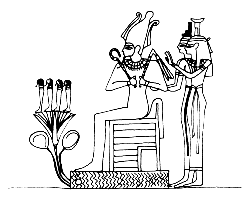
God associated above all with death, resurrection and fertility. In the Ennead of Heliopolis he is the son of Geb and Nut and the brother of Isis, Nephthys and Seth. Osiris and Isis are the parents of Horus. The most coherent story of Osiris's fate is that told by the Greek author Plutarch. According to him, Osiris was a mortal king whose good rule evoked Seth's jealousy. During a party, Seth announced that he would present a chest (i.e. a coffin) to whoever fitted into it perfectly; he had constructed the chest in advance using Osiris's measurements. Osiris got into the chest, upon which Seth locked it and threw it into the Nile. The chest floated to Byblos where it landed and a tree grew up over it. Isis found the chest and brought it back to Egypt where she wanted to bury her husband. However, Seth discovered this and chopped Osiris's body into pieces and scattered them throughout Egypt. Isis then searched for all the pieces and buried each where she found it. Parts of this tradition are not known from Egyptian sources, but some elements may be found in texts from as early as the Old Kingdom, for example his death by drowning and the finding of the body by Isis. The first information about Seth as Osiris's murderer date from the Middle Kingdom. An important difference between the tradition of Plutarch and the Egyptian sources is that in the former Horus was already alive, whereas the Egyptian tradition relates that Horus was conceived after Isis had gathered the body parts together into a mummy and reanimated it by blowing the breath of life into it with her wings. Osiris was worshipped from a very early period. It is assumed that he was originally a god of fertility, whose duty it was to ensure a good harvest; as such he was related to the Nile inundation. He quickly became the god of resurrection too. In the Old Kingdom, the deceased king was identified with Osiris, and his successor the living king with Horus. Later, as shown, for example, by the Coffin Texts and the Book of the Dead, every deceased person was considered to be an Osiris. Nevertheless, in the Pyramid Texts of the Old Kingdom a slightly negative attitude towards life in Osiris's underworld can be detected; continued existence in the sky, with the sun god Re, was considered the ideal. In later centuries the two 'destinations' would be brought more into balance with each other. The main cult centre for Osiris was Abydos, the capital of the eighth Upper Egyptian nome. One very important place of pilgrimage there was the tomb of King Djer (from the Protodynastic Period), which was later regarded as the tomb of Osiris. The annual festival for Osiris was celebrated in this city, during which the bark of the god was borne in procession and the victory of Osiris over his enemies was celebrated. Abydos was regarded as the location where the head of Osiris was buried, after his body had been chopped into pieces by Seth. The nome emblem of the city shows this head, wearing the Osiris crown with double feathers. Other cities were also associated with the body parts of Osiris, Busiris being one of the best known; this city was associated with the backbone of Osiris (see djed-pillar). Osiris was also associated with the mortuary god Sokar and with Ptah. Among his epithets, two of the most common are Wenennefer and Khentyamentiu, actually the name of the original god of Abydos whose cult was early amalgamated into and superceded by that of Osiris.
Osiris is depicted as a mummiform human figure. His hands and head are visible, however. In his hands he holds a staff of office and a flail, signs of royal dignity; on his head is the atef-crown, a white crown with a feather on either side and sometimes the horns of a ram. Occasionally, Osiris's skin is green, a reference to his fertility aspects.